As Hurricane Irma churned toward Florida’s west coast area last week, USF Bulls did not just hunker down or evacuate in preparation for the monster storm.
They rallied big time.
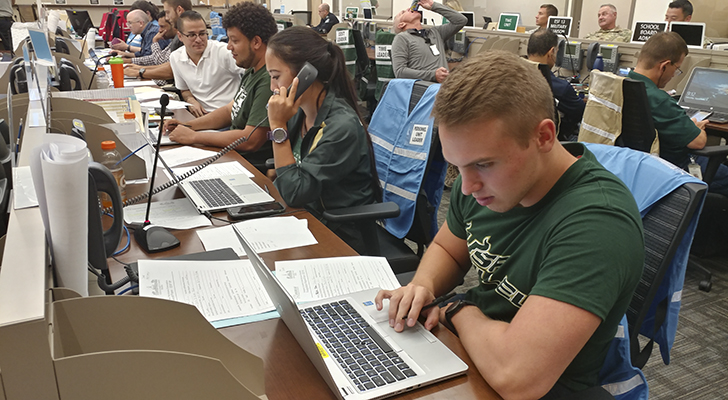
USF volunteers helped the community fill in the gaps for a wide variety of emergency response needs, including staffing EOC call centers.
USF employees spent countless hours planning for and responding to the storm during the week, some returning home only to shower and others working remotely. Just one example of the logistics required: USF kept more than 2,000 Tampa students who stayed in their campus residence halls during the storm safe, secure and well-nourished, and also housed some students from USF St. Petersburg, USF Sarasota-Manatee, off-campus Tampa students, faculty, staff and families from all three campuses, as well as Hillsborough County Sheriff and University Police officers.
The USF community also reached out to the wider Tampa Bay community -- caring for evacuees at area hurricane shelters, including the USF Sun Dome, the county’s largest shelter for people with special health care needs; fielding phone calls at emergency operations centers; and volunteering around the clock in partnership with local agencies to respond to a myriad disaster needs.
Here are just some of the stories about ways the USF family helped each other and the members of the public before, during and after Hurricane Irma:
Public health coordinates community disaster response
USF College of Public Health’s Elizabeth Dunn began working with emergency management undergraduate students to start disaster relief efforts last Wednesday when Tampa expected to be hit by a category 4 or 5 hurricane. County and city officials realized then they would need to rely on USF to help fill in the gaps in areas of need.
So, Dunn, director of the USF Community Emergency Response Team (CERT), collaborated with her CERT leaders, reaching out to organizations and colleges across USF to mobilize and, if needed, to train volunteers.
“With such a large storm coming and because of what was happening in Texas during Harvey, many resources were spread thin,” she said, “so we were trying to make sure there was nothing missed within our community.”
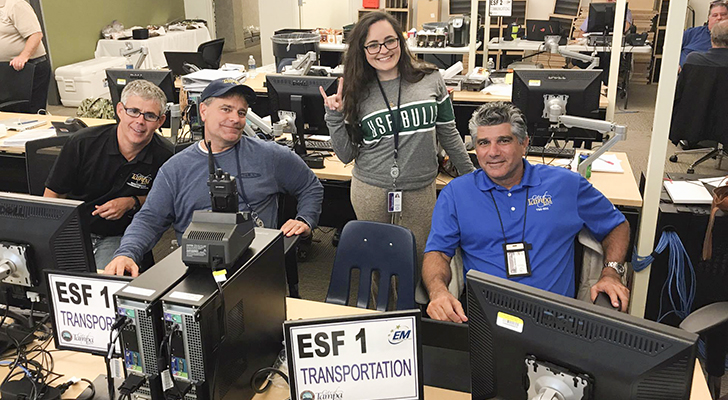
Recent USF graduate Angela Pitts (pictured) at the City of Tampa Emergency Operations Center, where she worked alongside Tampa Mayor Bob Buckhorn and other city staff during Hurricane Irma. She served as social media strategist for the center's Joint Information Unit, connecting residents with critical safety information.
The response to CERT’s call to action was gratifying.
“Our USF family definitely came forward when there was a need,” said Dunn, instructor and assistant to the Director of the Global Disaster Management, Humanitarian Relief, and Homeland Security program at COPH. “It was our chance to be part of something bigger than us.”
Some 200 USF students, faculty staff and alumni volunteered to support more than 25 agencies and organizations -- including the emergency management, health, public works and code enforcement departments in Hillsborough County, City of Tampa Emergency Management, American Red Cross, EMS Transport, Hillsborough Area Regional Transit Authority, Sunshine Line, Aging Services, and Hillsborough County Pet Resource Center, to name a few.
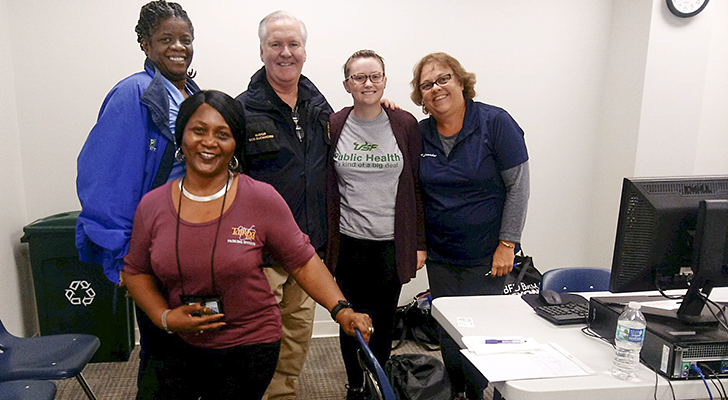
Amy Polen (to the right of Tampa Mayor Bob Buckhorn), a USF undergraduate student in environmental science and policy, put in 55 hours as a volunteer at the City of Tampa EOC over the Hurricane Irma weekend.
They served in many ways, including: managed and staffed 18 shelters, fielded calls at emergency operation centers and local TV stations to answer residents’ questions about safety, helped arrange transportation for those who needed to get to special needs shelters or the hospital, delivered food, water and supplies to communities in need, and helped county code enforcement assess wind and flood damage after the storm.
.jpg)
USF volunteers (including a couple of children of USF Bulls) delivered food and water to hurricane survivors at a distribution point in Dover on the weekend after Hurricane Irma. The USF Community Emergency Response Team worked with Hillsborough County Aging Services and other local CERTs to help manage the event.
Just a few examples: Jesse Casanova, who manages all international programs in the College of Public Health worked 13-hour shifts over five days at the emergency operations call center and was quickly made a supervisor. In addition to taking many calls from Spanish speakers, he provided triage between the shelters, the fire department and the police department, making sure people got where they needed to go without strife. COPH Associate Dean for Academic Affairs Kay Perrin, PhD, who is also a nurse, took hundreds of calls herself and was a resource for other volunteers who received health-related questions. Ellen Daley, PhD, associate dean for research and practice, and her family, opened and helped staff a shelter at Greco Middle School, while Joe Bohn, PhD, director of community engagement for COPH, provided a range of support and troubleshooting at two shelters, Middleton High School and Carrollwood Elementary School.
In Hurricane Irma’s
aftermath, CERT helped mobilize and train public health students for Disaster Survivor
Assistance Teams to identify those seeking resources for recovery, Dunn said.

Following the storm, USF public health students volunteering on a Disaster Survivor Assistance Team worked with code enforcement officers to assess flood and wind damage across Hillsborough County, including along the Alafia River.
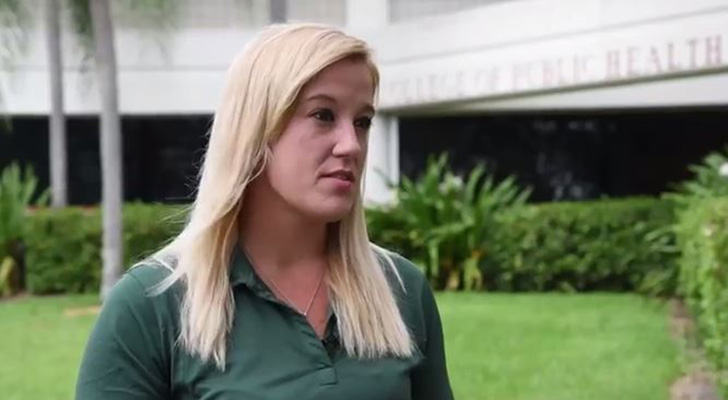
USF CERT Director Elizabeth Dunn works on disaster preparedness and response in the College of Public Health.
USF provides care, comfort at Sun Dome special needs shelter
At the USF Sun Dome special needs shelter, second-year USF medical students Ian Ciesielski and Amelia Ordonez joined physician volunteers from the USF Health Morsani College of Medicine, and a team from the University Emergency Medical Student Association (UEMSA), a USF student organization whose members are EMTs, paramedics or certified first responders. Together, this group of USF medical volunteers provided much of the hands-on medical care for ill and infirmed evacuees during around-the-clock shifts at the largest special needs hurricane shelter in the region.
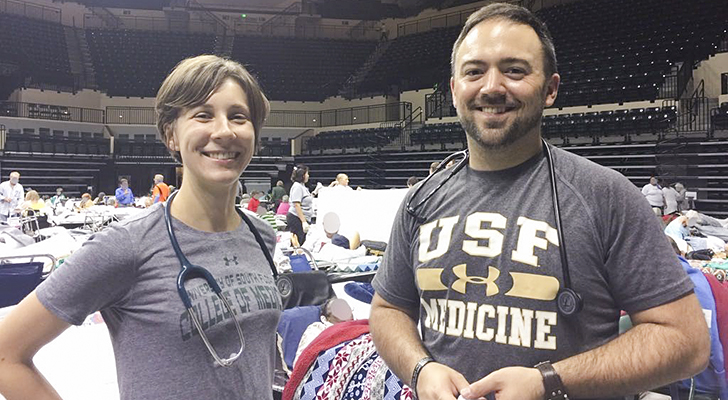
USF medical students and Amelia Ordonez and Ian Ciesielski were part of the team providing round-the-clock health care to evacuees who came to the Sun Dome, the county's largest special needs hurricane shelter.
Approximately 30 USF undergraduate students and some faculty from the Colleges of Nursing, Public Health and Pharmacy also contributed to the care of evacuees with special needs, said Douglas Holt, MD, director of the Hillsborough County Health Department, who arrived Friday morning to inspect and activate the Sun Dome -- one of the county’s three special needs hurricane shelters he would open over the weekend.
“USF played a comprehensive, prominent and holistic role at the Sun Dome shelter,” said Dr. Holt, who also directs the USF Department of Internal Medicine’s Division of Infectious Diseases and International Medicine. “The human connection and emotional comfort provided by these volunteers to special needs patients in a time of distress was as important as the medical aspect of care.”
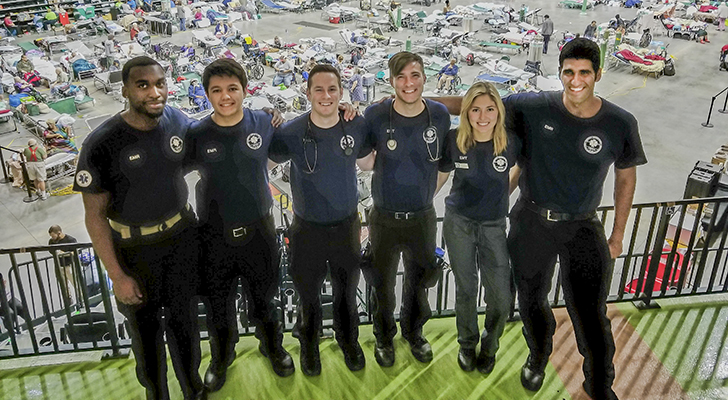
Volunteers from the University Emergency Medical Student Association (UEMSA), a USF student organization comprised of EMTs, paramedics or certified first responders, played a key role in providing hands-on medical care at the Sun Dome.
“When natural disasters hit, usually the people who are most needy are the ones who stay behind. We didn’t want to leave if they couldn’t,” said Ciesielski, who logged 70 volunteer hours. “The roof kept out the rain and wind, but the shelter came from everybody working there, even the patients taking care of one another.”
At their own expense the UEMSA volunteers provided equipment and supplies to monitor the medical conditions of evacuees. For instance, they contributed an additional portable automatic external defibrillator (AED), bandages, sterile dressings and a pulse oximeter to monitor the oxygen levels of the many persons on oxygen. When their supply of glucose meter strips was exhausted, they partnered with Tampa Fire & Rescue (TFR) to continue in-house glucose monitoring of diabetic patients using TFR supplies.
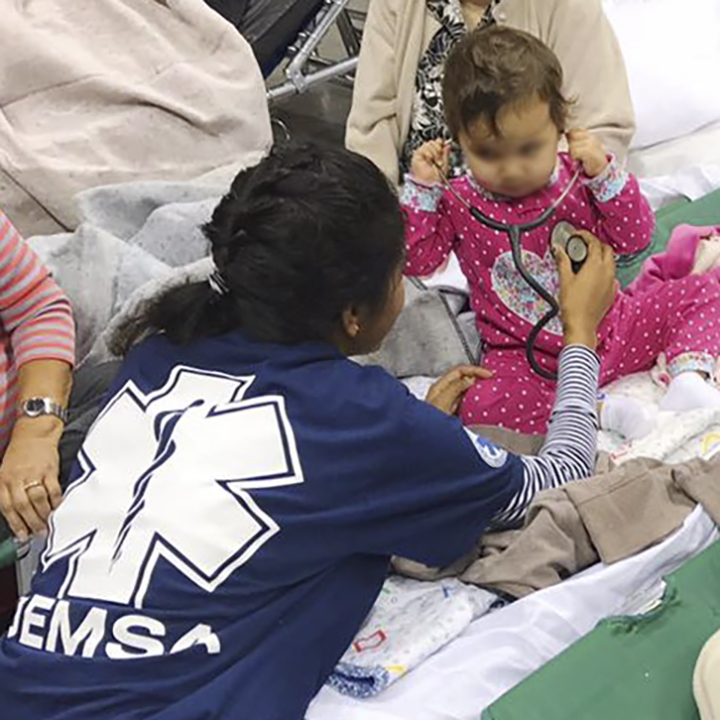
A UEMSA volunteer lets a child try out her stethoscope.
The medical students primarily monitored oxygen tanks, but like other volunteers they also pitched in to change linens, assist with bed baths, and stand in food lines for patients who could not. Volunteers created makeshift privacy rooms out of bed sheets, made extra cots out of palettes, cardboard and duct tape, and modified a wheelchair to accommodate a patient.
“Pretty much anything we could, we did,” Ordonez said, adding that the interaction with UEMSA members who had hands-on experience as first responders was valuable.
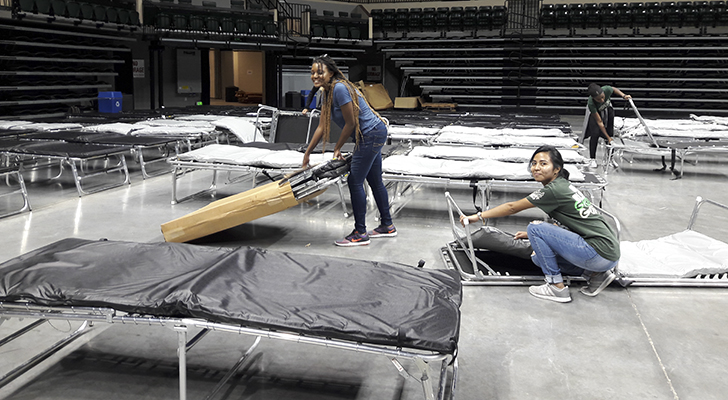
Student volunteers set up cots before evacuees arrive at the Sun Dome.
On Friday evening there were about 250 evacuees. That number shot up to more than 800 evacuees by the height of the storm with cots and wheelchairs covering the main floor and overflowing into the halls.
As the hurricane raged outside the Sun Dome Sunday night, shelter volunteer Brad Perich, a USF public health graduate student, filled in for a chaplain playing music to help ease frayed nerves. On an electronic keyboard, Perich performed the theme music from the TV series Game of Thrones, and for his finale he sang a rousing rendition of the song New York, New York.
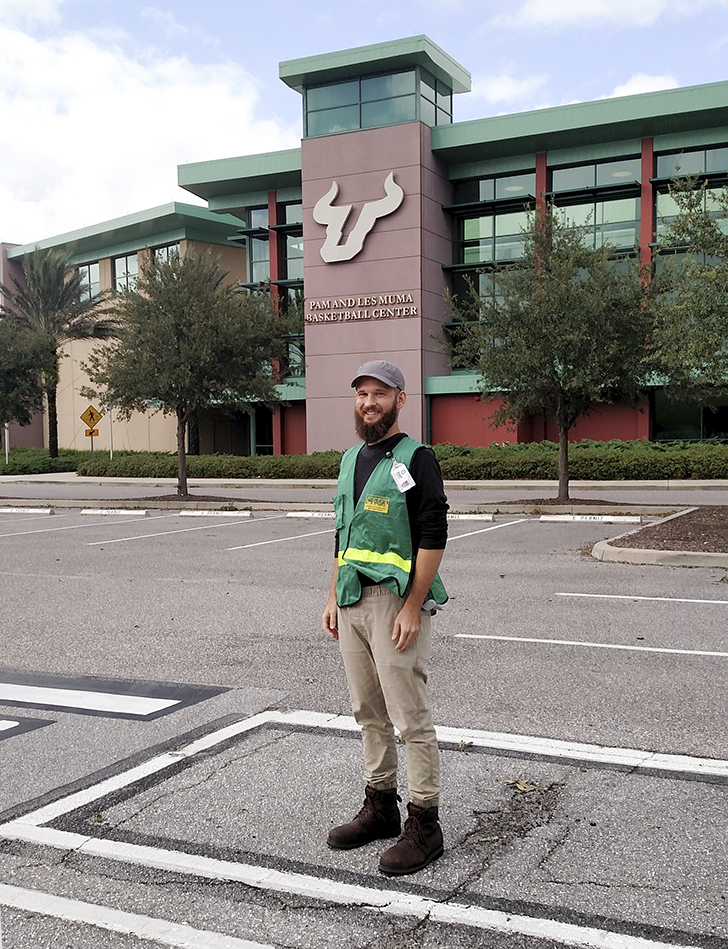
Brad Perich, MSPH candidate in epidemiology at the College of Public Health, played music for evacuees and volunteers inside the Sun Dome at the height of Hurricane Irma.
UEMSA volunteers included:Eric Arbeli, Aaron Gadomski, Jonathan Gallego, David Green, Victoria Heidersberger, Austin Jared, Rachel Kozak, Sudarshan Krishnamurthy, Nicole Liciaga-Silva, Victoria Lopez, Tiffany Ma, Saagar Majethia, Alejandro Menesess, Jamie Metzger, Malvin Moore, Dhvani Patel, Eitan Quitoriano, Chris Reenie, Sebastian Smith, Stella Varain.Dr. Stephen Poffis the group’s faculty advisor.
In addition to Dr. Holt, MCOM faculty from the Department of Internal Medicine, Division of Infectious Disease and International Medicine volunteering at the Sun Dome included: Lyn Menezes, PhD; Marian Menezes, MD; Zack Gales, MD; Eric Zhao, MD; as well as international physician trainees (and one nurse trainee) from China: Shaopeng Yang, MD; Haibin Zhong, MD; and Shuming Xu, MD; and Xiao Tong Zheng, RN.
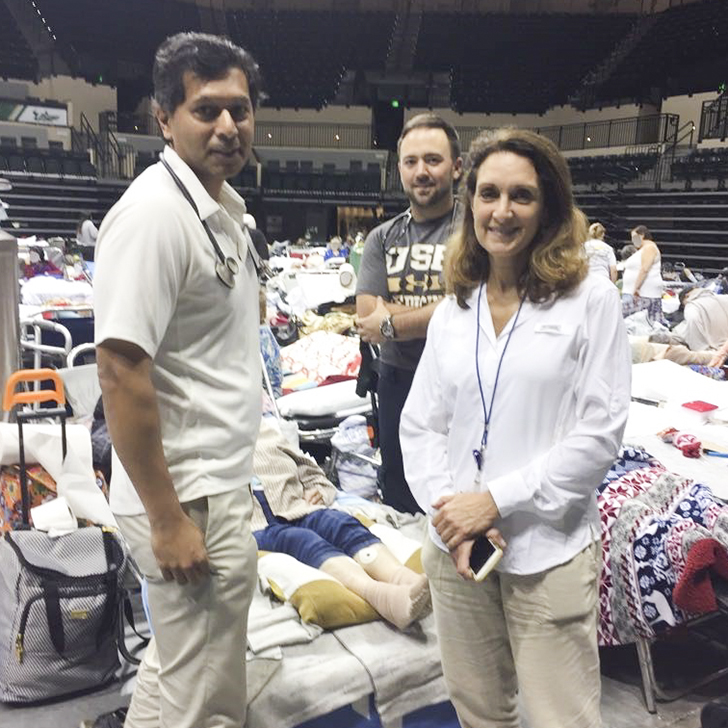
Marian Menenzes, MD, (left) a USF clinical affiliate faculty member in pulmonary and critical care, with "Dr. Jo," the medical reporter for Fox 13 News, a physician and alum of USF's residency program.
USF Sun Dome staff, led by Director of Operations Tripp Turbiville and General Manager Rhett Blewett, were critical in attending to patient care and volunteer needs, including electrical needs, food service, delivery service and anything that was asked of them 24/7, Dr. Holt said. USF Police were also on hand at the shelter to offer assistance and security.
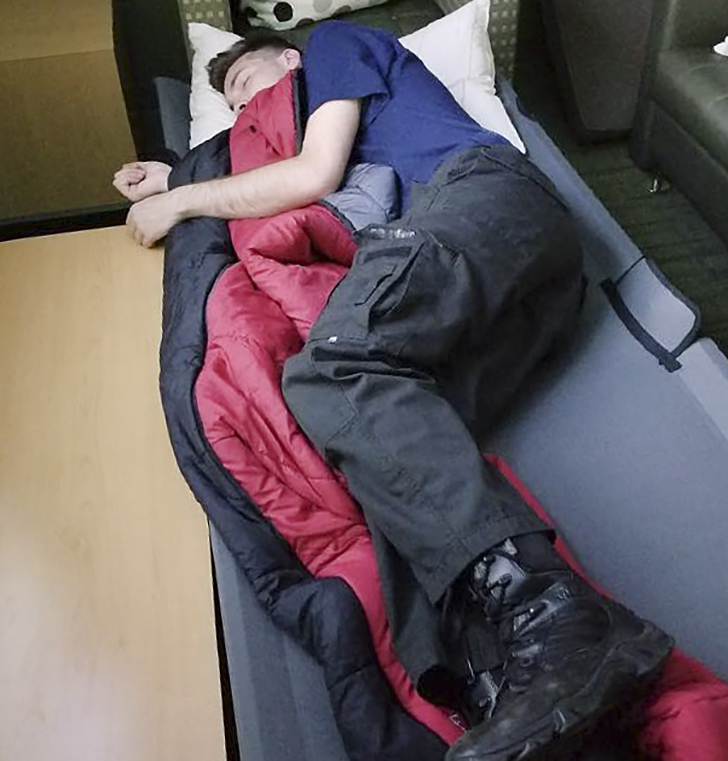
Medical volunteers at the Sun Dome caught some sleep whenever they could between shifts.
MCOM physician residents ride out
storm with hospital patients
Known as “Team A,” 163 Morsani
College of Medicine residents (physicians in training) rode out the hurricane
for the three days, Saturday Sept. 9 through Monday evening, Sept. 11, caring
for patients at USF Health affiliated hospitals, including Tampa
General, Moffitt Cancer Center, James A. Haley Veterans’ Hospital, Johns
Hopkins All Children’s Hospital and several others.
Many residents even volunteered for
“Team A” duty during the hurricane, with some evacuating family members and
leaving homes unattended without knowing what damage might await their return.
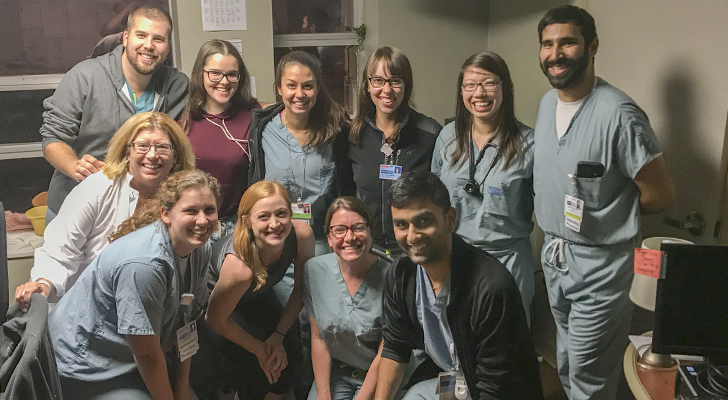
Patricia Emmanuel, MD, (in white coat) chair of the Department of Pediatrics, poses for a quick photo with pediatrics and pediatrics-internal medicine residents while Tampa General Hospital was on "lock down" the evening of Hurricane Irma.
“The
residents really were the unsung heroes in this storm,” said Patricia Emmanuel,
chair of the Department of Pediatrics.
“They covered so many hospitals and stayed for days.”
Four of the eight emergency medicine residents working over the hurricane weekend at TGH, did so voluntarily, said David Orban, MD, director of the USF Division of Emergency Medicine.
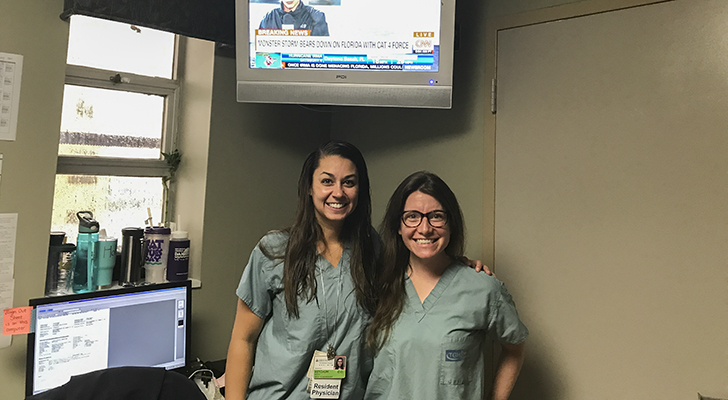
Residents Colleen Maier, MD, and Ashley Ketchum, MD, in the pediatrics resident room at Tampa General. On the TV screen above them, CNN reports on the hurricane from nearby Bayshore Boulevard.
Tampa General continued taking transfers of patients from other hospitals right
up until the time the winds got too high.
The first floor nursing unit moved all their patients to beds on the
Emergency Department’s second floor, because of concern there would be a 5-to
8-foot storm surge on Davis Islands, Dr. Orban said. “Our residents and faculty
provided the physician care for these 20 additional patients for 24 hours while
the storm passed over overhead, because most of the TGH inpatient physician
staff were not in the hospital and had no power at home, so could not put
orders into their computers for Epic (the electronic health records system).”
After the first after-storm ambulance crossed the Davis Islands bridge at 4 a.m. Monday, Team A stayed very busy in the ER, Dr. Orban said. “We saw lots of minor injuries from the storm, critical care patients transferred from other hospitals, and displaced persons from the hurricane shelters.”
Planning, scheduling and setting up a communication system to weather the hurricane was a massive group effort, said Cuc Mai, MD, assistant dean for the USF Health Morsani College of Medicine Graduate Medical Education program. “But it shows the dedication that USF has to providing continuous patient care."
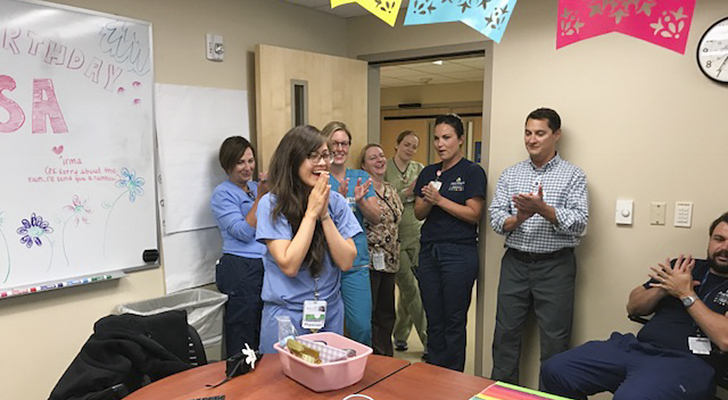
USF pediatrics intern Lisa Dinh, who volunteered to work at Johns Hopkins All Children's Hospital in St. Petersburg, had a birthday while working through the storm. Colleagues pulled together an impromptu celebration.
When Bay Pines VA Medical Center in St. Petersburg was evacuated as Hurricane Irma approached, some residents working at Moffitt quickly moved to Haley Veterans’ Hospital to help triage 57 patients transferred from St. Petersburg to the Tampa VA hospital, Dr. Mai said.
Candice Meteja, MD, associate program director of USF’s Internal Medicine Residency, was among the many clinical faculty who offered to open their homes to USF residents living in evacuation zones. But while working at the hospital, Dr. Meteja -- who volunteered to supervise residents at Tampa General during the storm -- hosted nine evacuees: five residents, one spouse, two pet cats and one dog.
“Even if we were anxious, everyone pulled together and decided that we were going to get through this together,” said Dr. Meteja, who hails from Chicago and said Irma was her first hurricane.
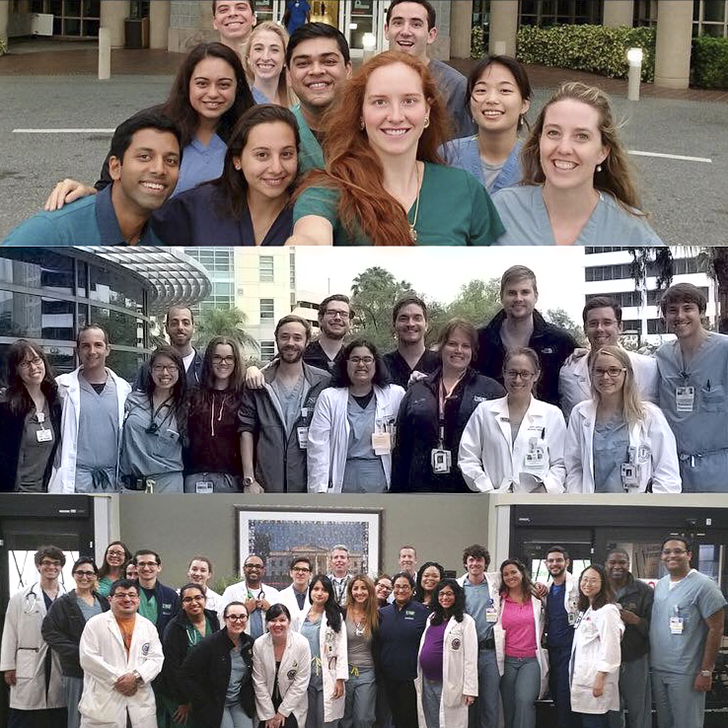
"Team A" internal medicine residents who worked, from top to bottom, at Moffitt Cancer Center, Tampa General Hospital and James A. Haley Veterans' Hospital during Hurricane Irma.
USF shares fuel with FSU to save the art
During
the hurricane, USF Sarasota-Manatee, like so many other places throughout the
state, lost power. USFSM campus personnel were in regular contact with the USF
System Emergency Operations Center, activated on the Tampa campus. So when the
normal fuel vendor for USFSM was unable to deliver fuel to operate an emergency
generator, a plan was put in place for USF Tampa to deliver fuel to USFSM.
Soon after that, a call came in from New College reporting that the college was running low on fuel. Christopher Duffy, assistant vice president for USF Facilities Management, sent a team in a 2,500-gallon fuel truck down the coast to replenish fuel and keep the generators powered for both institutions.
.jpg)
Team of drivers delivering USF fuel down the coast, to neighbor universities: Jose Tirado, James Gillilan, and Jimmy Davis.
USF also fielded a call from Florida State University – their facility at the Ringling cultural campus in Sarasota had no power and the generators running the temperature control systems protecting the entire art collection in the Ringling Museum of Art, as well as other buildings, were quickly running out of fuel. That same USF team of drivers was able to provide fuel to FSU the Tuesday after the Hurricane, as well as schedule round trips on Wednesday, Thursday and Friday. USF will continue the fuel shipments until power is back on, Duffy said.
The
team of drivers delivering fuel are Jimmy
Davis, James Gillilan, and Jose
Tirado, coordinated through Ray
Curbelo, manager of Waste Management and Vehicle Shop.
University
Police respond in midst of high winds
In the midst of the hurricane, two University Police Department (UPD) officers – Lt. Dominic Marckese and Assistant Chief Sal Simonetti – assisted a pregnant woman sheltering at Pizzo Elementary. Nine months into her pregnancy, the woman had begun feeling labor pains, and someone from Pizzo called in a medical emergency to USF Police at 9:30 p.m. on Sunday, Sept. 10.
“Our Communications Center requested that Tampa Fire Rescue respond to assist, but they indicated they were not responding due to the high winds at the time,” reported Capt. Meg Ross, public information officer for UPD. “The University Police had previously given the order for all our officers to seek shelter due to the sustained high winds at the time (approx. 50 mph).”
Marckese and Simonetti quickly decided to pick up the woman at the shelter and transport her to the Florida Hospital Emergency Department in a police vehicle. They did all this within 20 minutes of the initial call. Upon UPD follow-up the next day, the hospital reported the woman had not given birth and was released, Ross said.
.jpg)
University Police Department's Lt. Dominic Marckese and Assistant Chief Sal Simonetti
College of Nursing shares hurricane
stories
At the height of the storm, USF College of Nursing student Blake Burklow was
taking care of patients in the transplant unit at Tampa General Hospital. Because
the hospital is located in a Level A evacuation zone, it was considered highly vulnerable
to storm surge. Allen helped relocate all three floors of the transplant unit
to another area within the hospital to keep patients safe. “It was an experience that I definitely will
not forget, and I am certain that it will make me a better nurse.” said Allen
said, who spent three days and two nights at TGH.
Jessica Panasewicz, a USF
nursing student in the Veterans to Bachelor of Science program (VCARE) and
medic in the U.S. Army National Guard, was deployed for duty Sept. 7, right
before Hurricane Irma touched U.S. soil.
Moving with her unit throughout the state, she has been supporting
communities, distributing water and providing overall security before and after
the storm’s arrival. She is currently
based in Sarasota.
USF nursing student Julia Jara came from caring for patients in a Houston
hospital after Hurricane Harvey to taking care of patients in a Tampa hospital
right before Hurricane Irma. The
back-to-back disaster relief assignments through the HealthTrust agency left
Jara with a unique perspective on how two communities came together to cope
with the storms.
Sally Galloway, assistant to associate dean in College of Nursing, opened her home to friends who were local Irma evacuees, including a family from mobile home park and an elderly couple. The group of nine friends pitched in to clean up Galloway’s yard the next morning, and celebrated the minimal damage and restored electricity by preparing and enjoying a full Thanksgiving feast of turkey, dressing, mashed potatoes, roasted carrots and cherry pie.
Students
reach out to downtown homeless
The evening before Hurricane Irma hit, USF student volunteers made and passed
out several hundred sandwiches to the homeless in downtown Tampa. The group also
went to multiple stores to buy water, by then in scarce supply, and finally
gathered enough cases to give everyone at least one bottle. They put together
mini bags that included candles and batteries.
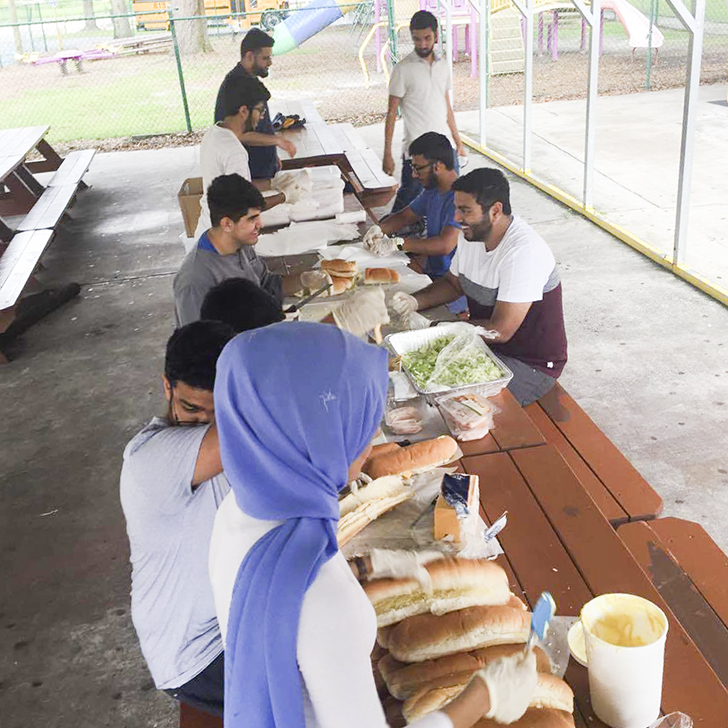
Members of the USF student organization Project Downtown Tampa made and handed out sandwiches and bottled water to the homeless in downtown Tampa the evening before Hurricane Irma.
“We wish there was more we could have done, but given the time frame we are thankful to have at least been able to give that, and to have safely made it to and from downtown Tampa where the shelters we visit are located,” said Yasmeen Alkishawi, president of Project Downtown Tampa, a student support organization dedicated to the physical, intellectual, and emotional empowerment of Hillsborough County’s homeless population.
USF Health leadership lends a hand
On
the Friday before Hurricane Irma, Kevin Sneed, PharmD, dean of the College of
Pharmacy, delivered much-needed medications to about half-dozen patients who
use Pharmacy Plus and whose shipments of medications had not come in before the
storm. He drove to pharmaceutical
warehouse in Lakeland to pick up the medications, then back to Tampa to deliver
prescriptions to the patients’ doors.
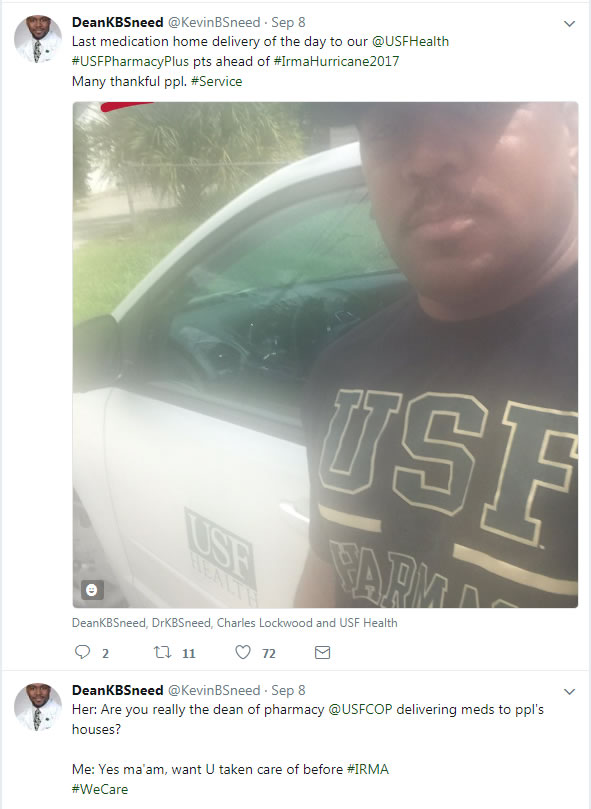
From Saturday through Monday morning, Charles Lockwood, MD, senior vice president of USF Health and dean of the Morsani College of Medicine, working in coordination with USF Student Health Services Medical Director Joe Puccio, MD, who triaged calls, served as the onsite physician for USF students and staff remaining on the Tampa campus during the storm. He housed on campus in one of the dorms during Irma, eating meals with students at the Hub.
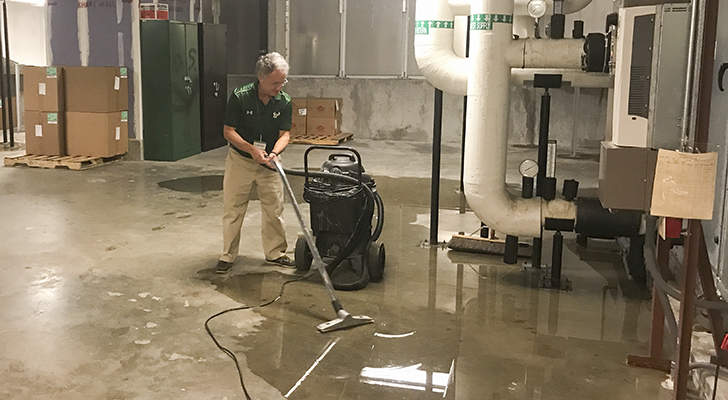
Charles Lockwood, MD, senior vice president for USF Health and dean of the Morsani College of Medicine, pitches in with post-Irma clean-up at the Morsani Center for Advanced Healthcare.
USF
Housing provides shelter from the storm
USF Tampa was host to nine students from USF St. Petersburg and 25 students from USF Sarasota-Manatee. Housing accommodations were found and all had a safe place to ride out the storm. The invitation was extended to faculty and staff from those campuses as well, who sheltered in multipurpose rooms, said Ana Hernandez, assistant vice president of USF Housing and Residential Education. Joining the shelter were Hillsborough County Sheriff officers and University Police Officers, all of whom used the space for much need rest between work shifts.
From hurricane research to hurricane volunteers
Led by Associate Professor Jennifer Collins, a team of faculty and students from the USF School of Geosciences deployed pre-Hurricane Irma to highway rest stops, including the Florida Turnpike, to interview residents leaving to avoid the storm about their evacuation experiences. When the storm was imminent several of the team’s graduate students transitioned from their outdoor hurricane research to volunteer inside a hurricane shelter at Greco Middle School.
The research expanded post-Irma to include non-evacuees, as Collins and Robin Ersing, a faculty member in the USF School of Public Affairs, were awarded a National Hazards Center Quick Response Program grant to study the relationship between evacuation decisions and social connections. In addition to Collins and Ersing, the team includes Vikrant Pendharkar, Saurav Chakraborty, Amy Polen, Simran Gill, Christian Santiago, Emily Cerrito, Michelle Saunders, Luwen Wang, Brad Perich, and Sinjana Kolipaka.

Simran Gill, an Honors College student majoring in biomedical sciences, interviews a Hurricane Irma evacuee at a highway rest stop north of Tampa before the storm hit. She is a member of a USF School of Geosciences team, led by faculty member Jennifer Collins, conducting ongoing research on the relationship between evacuation decisions and social support.
Aiding those disproportionately affected by disasters
At Suncoast Community Health Centers, a federally qualified health center with locations in east and south Hillsborough County, underserved patients receive care from USF Health physicians and nursing and pharmacy students through a Health Resources & Services Administration-sponsored Geriatric Workforce Enhancement Program grant.
A significant number of the Suncoast clients live in mobile homes that were damaged by Hurricane Irma’s wind and/or flooding.
In the aftermath of the hurricane the clinics saw an uptick in the patients with diabetes whose refrigerated insulin had expired because they lost power, so providers helped them replace the medication, said Asa Oxner, MD, assistant professor in the Department of Internal Medicine, USF Health Morsani College of Medicine. They also cared for those needing blood pressures stabilized.
“They were very stressed out,” said Dr. Oxner, who oversees USF Health students and residents at the center’s Brandon/Palm River location while fellow faculty member Kimberly Martin, MD, oversees students at Suncoast’s Dover site. “Losing three vials of insulin for someone who spends a third of their income to buy that insulin is really devastating.”
Those experiencing health disparities are often disproportionately affected by disasters, so it was gratifying to be able to help ease a little of their anxiety and provide some brief respite, she said. “One patient who finished her (medical) visit with us asked if she and her family could just sit in the lobby and soak up the air conditioning until we left for the day.”
The news must go on
At WUSF Public Media, essential personnel worked around the clock providing coverage of Hurricane Irma and continue to report on the record-setting storm that impacted nearly the entire state -- from wind and flood damage to evacuations, gas shortages and power loss affecting millions. WUSF also hosted a standby crew from WFLA-TV, which uses the WUSF-TV station as an emergency backup site, said JoAnn Urofsy, general manager of WUSF Public Media.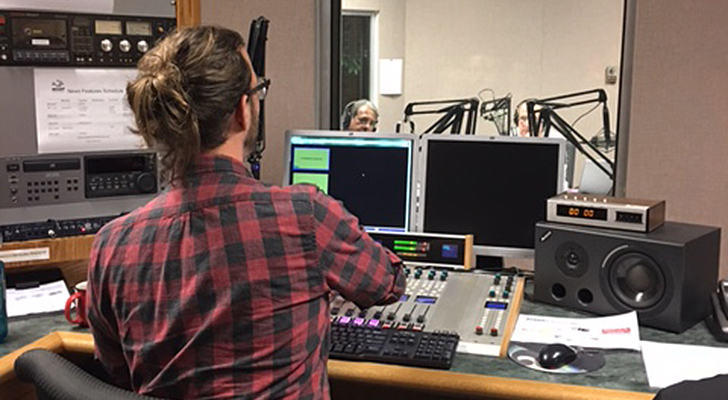
Staff members who came to the WUSF radio and TV stations at the USF Tampa campus to work, and stayed overnight, were: Michael Cornette, Dominic Walker, Russell Gant, Gregory Kline (Tyler), Chris Sampson, Dale Goodwin, Craig Georg, Richard Jimenez, George Gauvin, Willow Wright, Alfred Zimmerman, Ava Perline, John Vestic, Sheila Rue, Mary Shedden, Julio Ochoa, Cathy Carter, Lisa Peakes, Carson Cooper, Susan Wantuck, Stephanie Colombini, Mark Miller, Mark Schreiner, Daylina Miller, and JoAnn Urofsky.
The following staff members worked remotely during the hurricane: Bobbie O’Brien, Robin Sussingham, Maria Gigliotti, Jonathan Horwath, and Marilu Hernandez.
***
Several
from USF were interviewed via Facebook
Live to share their stories,
offer thanks and give perspective about everyone coming together.
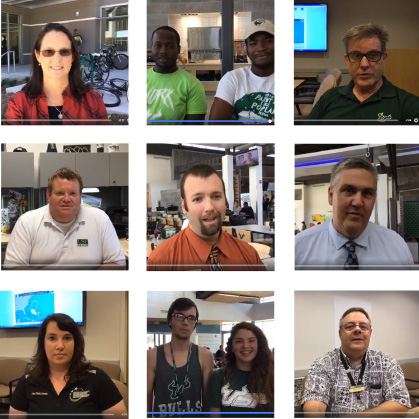
Anne DeLotto Baier and Sarah Worth, University Communications and Marketing, and Elizabeth Brown, USF College of Nursing Communications, contributed to this story.